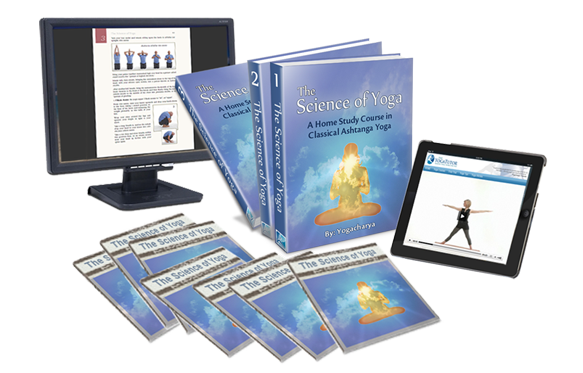[ Excerpt from The Science of Yoga, page 121 ]
There are many versions of the surya namaskara kriya, or sun salutation, generally encompassing anywhere from 11 to 14 different positions.
Here I will be instructing you in a simple version known as aruna surya namaskara. Aruna means "red," here signifying that brilliant luminescent warmth and energy of the sun. Some other forms include the vedic surya namaskara, maha sauri surya namaskara, veerya surya namaskara, and the popular Rishikesh surya namaskara.
Aruna Surya Namaskar
In the beginning this kriya should be done very slowly. Use a 6 count with the breath (both for the inhale and exhale), and then hold the breath for a 3 count within each specific pose (a 2:1 breathe:hold ratio).
Begin your practice with only 2 or 3 complete rounds, gradually increasing the frequency with practice to anywhere from 10 to 20 rounds in succession.
Technique
- Begin in sama sthiti asana, the erect, equal balanced pose.
- Clear you mind of any extraneous thoughts, and let a feeling of reverence and respect for the sun fill your mind. (Try to maintain this mental posture throughout all the movements.)
- Inhale, to a 6 count, and slowly raise your arms in a wide circle into tala asana, the palm tree pose, with your palms open towards the sun.
- During the held-in breath (3 counts), bring the palms together into anjali mudra and extend backwards into a controlled backbend.
- Exhale, to a 6 count, and slowly fold forward at the hips into pada hasta asana, keeping your arms fully extended throughout the movement.
Note: Let your palms rest flat on the floor beside your feet if you able, or else let them grasp lightly around the ankles or lower legs. Let the head and neck dangle freely.
- Hold the breath out for a 3 count
- Inhale (6 counts), straighten the spine and lift your head and neck to look straight forward.
- While holding the breath in (3 counts), place you palms flat on the ground and jump with both feet (or step one leg at a time) backward into chataranga danda asana, the four-footed stick pose.
- Perform chataranga danda kriya, the four-footed push-up action, by exhaling (6 count) as you lower yourself down towards the floor.
Note: Try to hold the body as a ‘rigid plank’ 2 to 3 inches above the ground with the breath held out for a 3 count.
- Inhale (6 counts) and push the arms straight, while keeping the hips down, into kokila asana, the cuckoo pose, with the head and chin up.
- Hold the breath in for 3 counts.
- Exhale (6 counts) and drop your head and shoulders down while pushing your hips and tailbone up into meru asana, the pose of the mountain.
- Pause here and take several long and slow breaths in the sukha rhythm (6 counts in and 6 counts out). Finish with a full exhalation and hold the breath out for a 3 count.
- Inhale and jump forward with both feet (or step one leg at a time) back into the forward flexed standing position, with the spine extended and head and chin up.
- Hold the breath in for 3 counts.
- Exhale and relax the spine, head and neck downward into pada hasta asana.
- Again, hold the breath out for 3 counts.
- Inhale (6 counts), slowly coming back up into tala asana, again with a wide circling of the arms.
- Hold the breath in for a 3 count.
- Return to sama sthiti asana with a 'sunburst action', a wide circling downward of the arms throughout a controlled backbend, while exhaling to a 6 count.
NOTE: Use caution when back-bending.

Variations:
A Try a faster pace - breathe (inhale or exhale) for 2 counts during the movements, and hold the breath (in or out) for 1 count while fixed briefly in the poses.
B Try a slower pace - breathe (inhale or exhale) for 8 or 10 counts during the movements, and hold the breath (in or out) for 4 or 5 counts respectively while holding the poses.
Health Benefits of Surya Namaskara Kriya
This daily practice in yoga is a boon for youthfulness, vigour and vitality. Its variations allow opportunity for men and women of all ages to enjoy its many benefits. Below is a list of a few:
- Aids in the development of good breathing.
- Creates a strong, straight and flexible spine.
- Increases blood supply and stimulates nervous activity throughout the entire spinal area, nourishing all of the internal organs, strengthening the heart, liver, stomach, kidneys and bowels.
- Stimulates and activates glandular activity.
- Energizes the nervous system and invigorates the being.
- Aids in digestion and combats constipation.
- Promotes circulation to improve cardiovascular fitness, along with flexibility of many major joints in the body.
- Combats lethargy and general stiffness.
- Promotes healthy, elastic and resilient skin.
- Stimulates mental activity, promoting alertness, awareness and a youthful mind.
[Continued...]
DISCLAIMER:
The contents of this web page are intended for informational purposes only. One should not engage in any yoga practices based solely upon the directions given on this web page or any other page of this web site. Anyone atempting to perform any of the yoga exercises introduced on this website assumes full responsibility and does so at their own risk.
---------------------
NOTE: This yoga article is an excerpt from The Science of Yoga, an online yoga training program with streaming yoga videos and 600 pages of step-by-step yoga instruction.

"The Science of Yoga is a course worthy of
leather binding and an honored place in the
finest libraries in the world
... It is indeed a masterful work."
Dr. John Michael Christian
AwakeningWithYoga.com
Learn More About
The Science of Yoga Course
|







